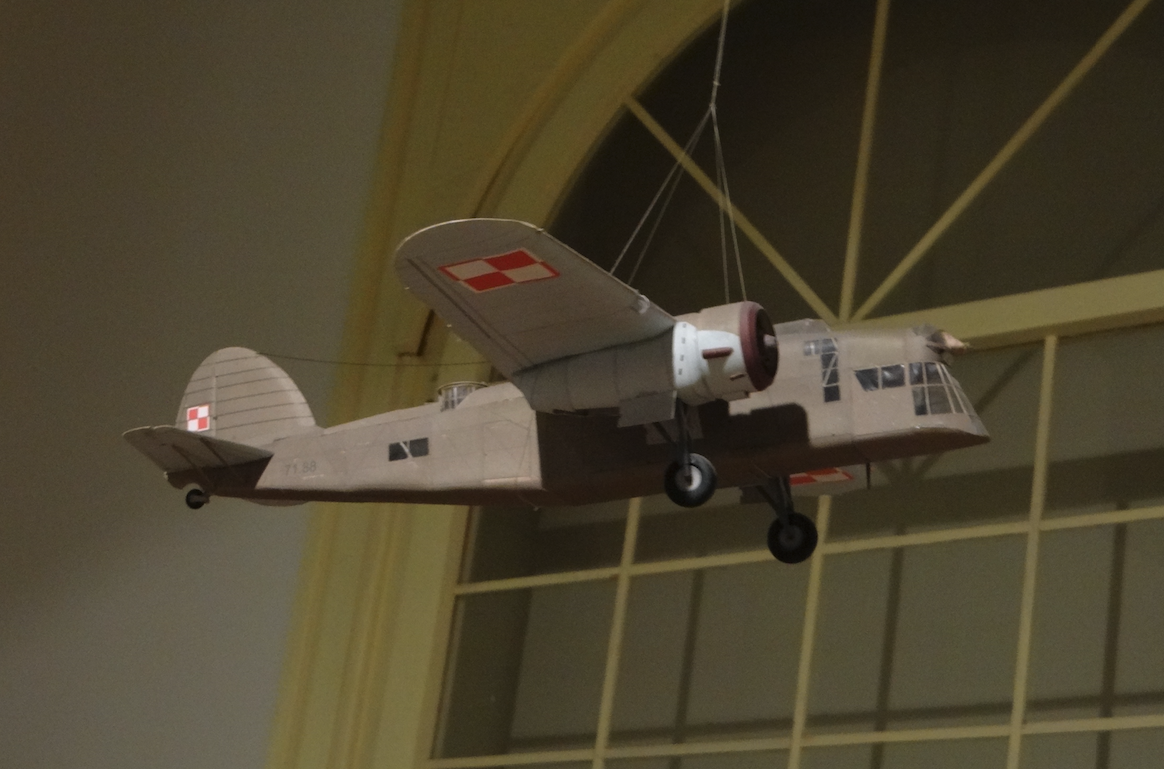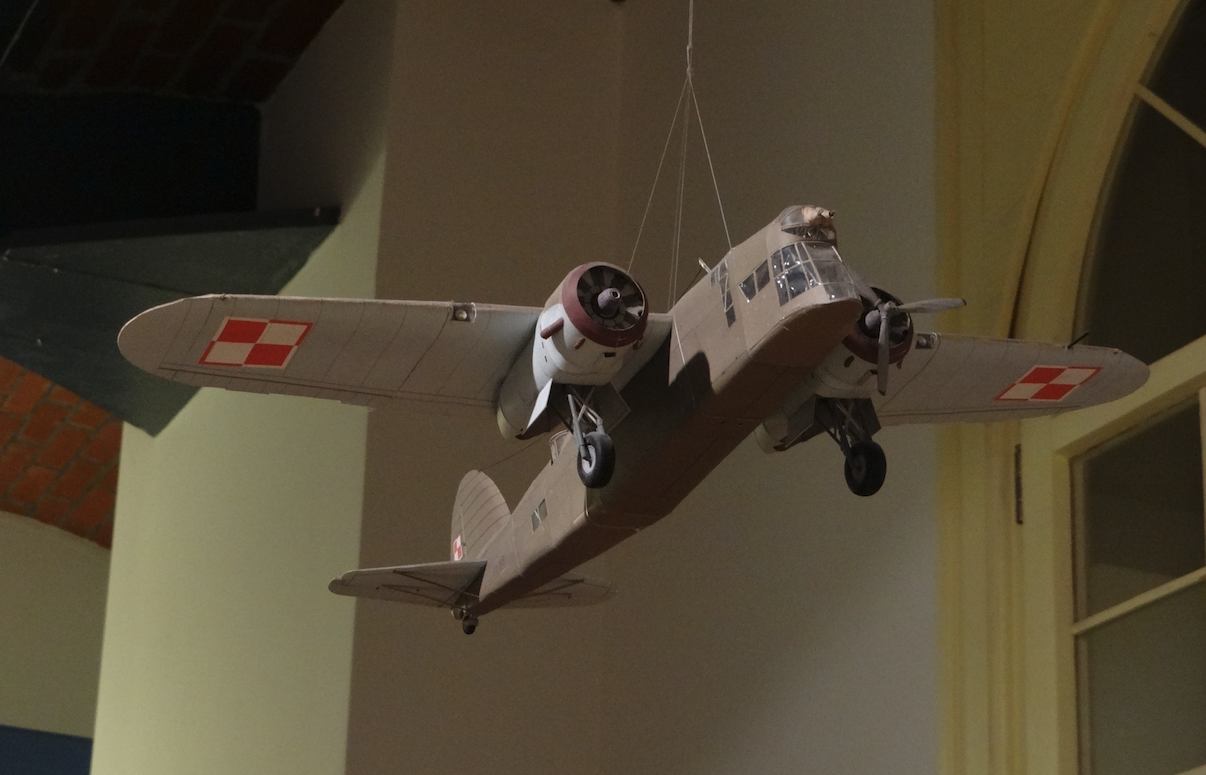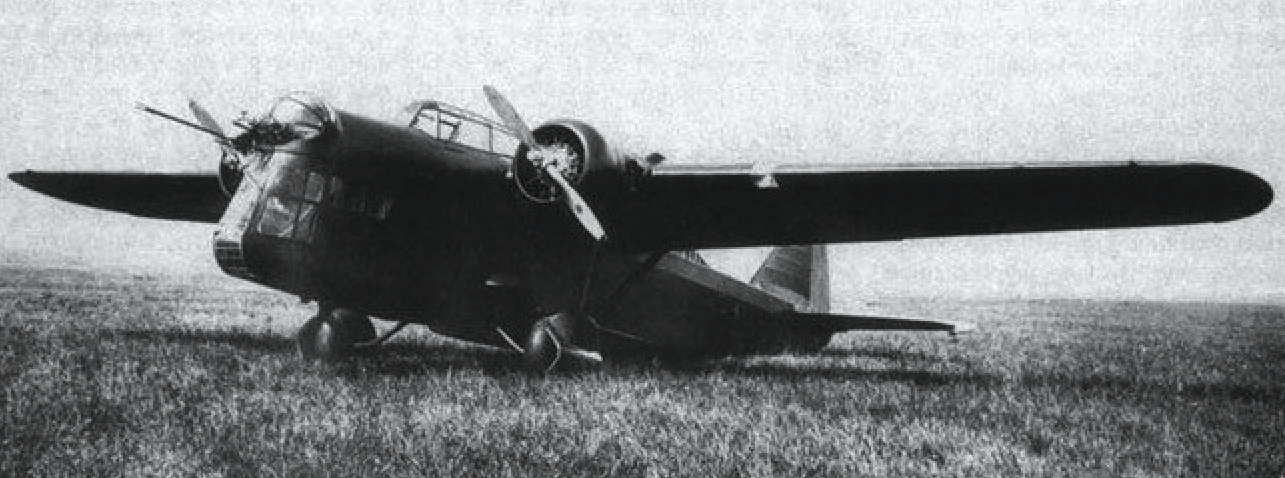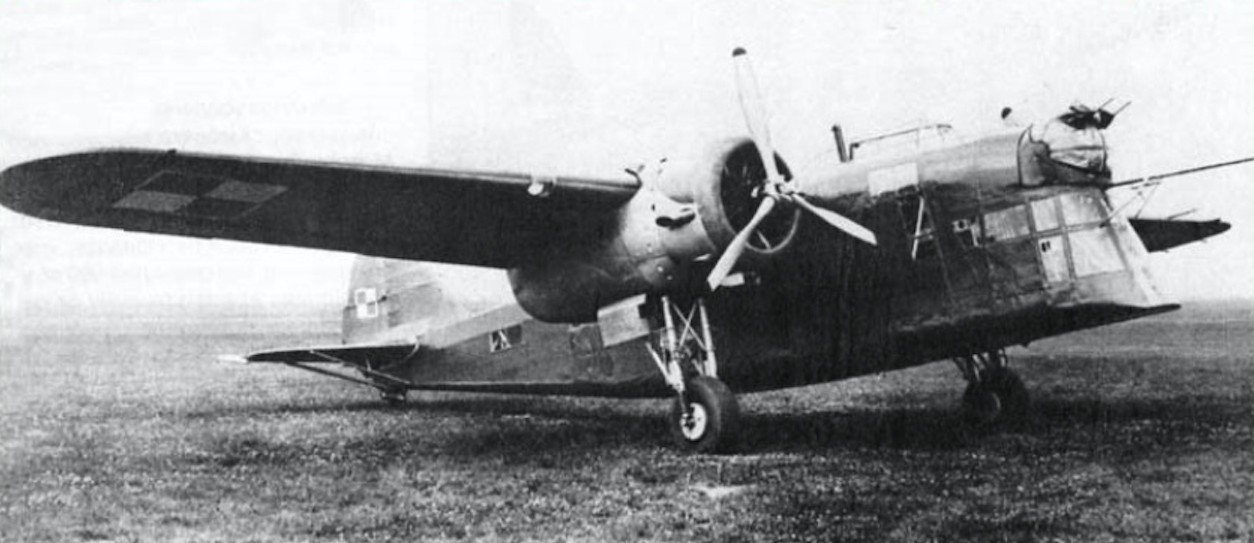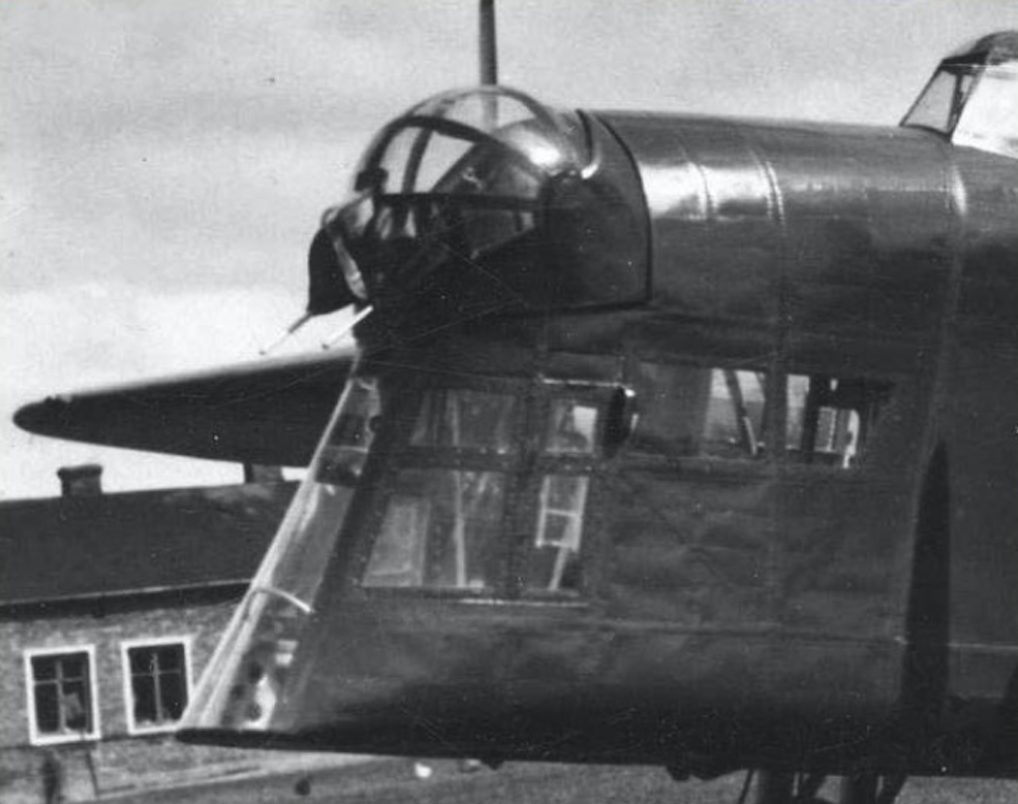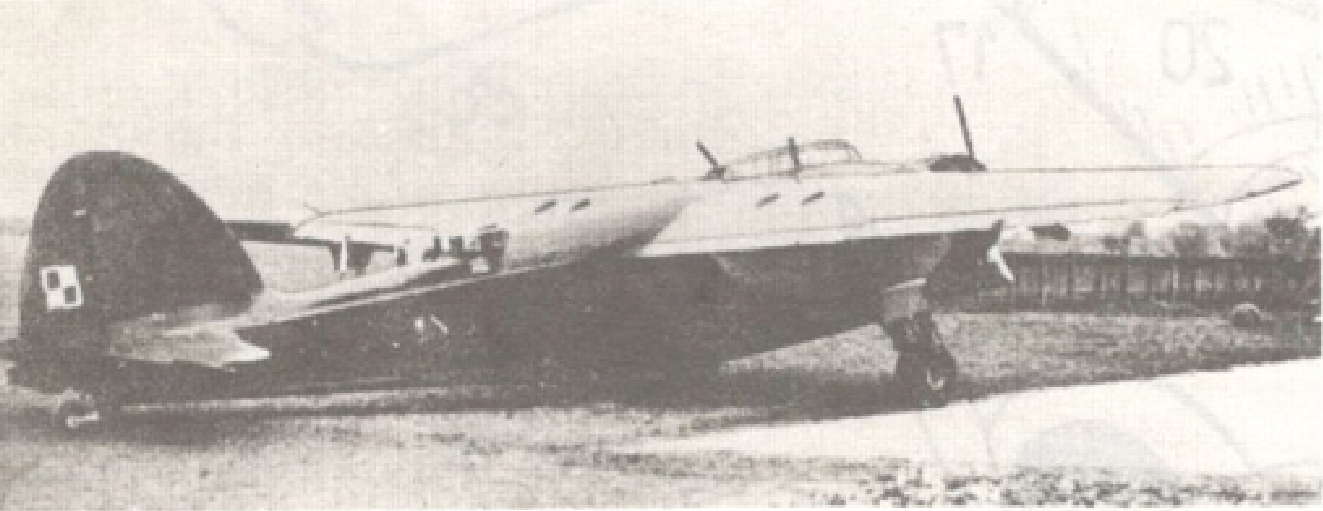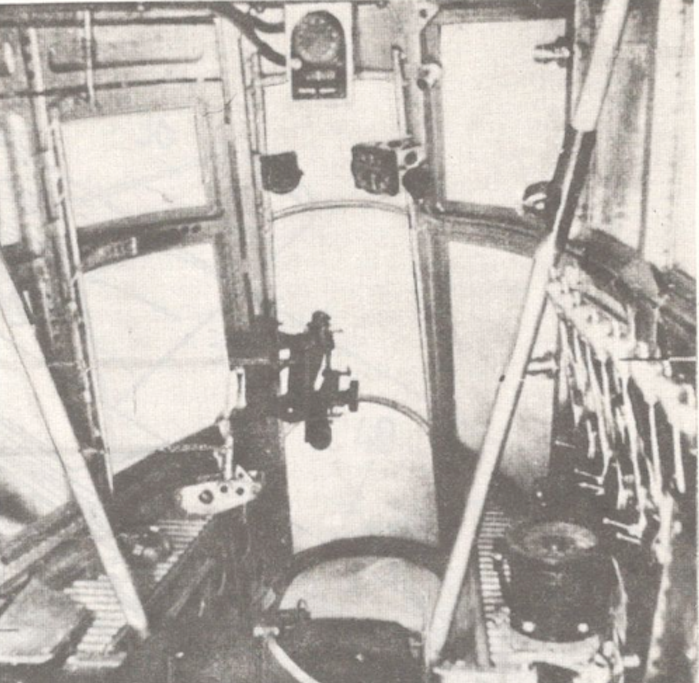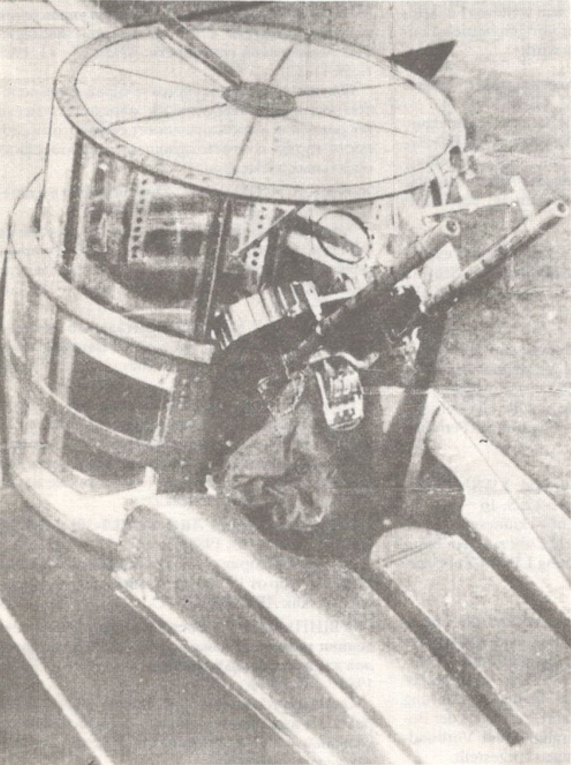Kraków 2020-02-15
00136c Section 1936-03-15
Państwowe Zakłady Lotnicze PZL-30, LWS-6 Żubr
Poland
History
History PZL-30, LWS-6 Żubr.
In 1933, Państwowe Zakłady Lotnicze in Warsaw received an order for a passenger plane from PLL LOT from the Civil Aviation Department of the Ministry of Transport. The new aircraft was to replace Fokker F-VII B / 3m aircraft used in PLL LOT. The plane was to be powered by two engines and take 12-14 passengers on board.
In 1931, the PZL-27 aircraft was designed in PZL in Warsaw, which was to be a post-communication aircraft. Its constructor was the engineer Zbysław Ciołkosz. PZL-27 was a three-engine, 7-seat aircraft. Mixed metal-wooden construction. At that time, it was estimated that an all-metal plane would be heavier than a mixed-plane aircraft. Not all metal working processes have been mastered.
As work on the PZL-27 was nearing completion, the work on a new passenger plane was commissioned to engineer Zbysław Ciołkosz. The passenger plane was designated PZL-30. The aircraft was designed in a high-wing system with two engines. The fuselage was designed as a welded structure made of steel pipes joined by welding. Wings with wooden structure covered with plywood. The plane was to take 12 passengers or 1,000 kg of cargo on board. Range of a minimum of 1,000 km. Two Pratt Whitney Wasp Junior star engines with 295 kW (400 hp) were selected for the drive. These engines were known for their good quality and reliability.
In 1934, the aircraft documentation was completed, wings were built and the fuselage structure was welded. At that time, LOT Polish Airlines decided to buy Douglas DC-2 aircraft and withdrew from the PZL-30 project. PLL LOT paid PLN 200,000 to PZL for the costs incurred.
At that time, the Department of Aviation of the Ministry of Military Affairs planned to order a new bomber plane. Therefore, engineer Jerzy Dąbrowski started working on the PZL-37 Łoś bomber. Because the PZL-37 Łoś project was a high risk project, it was decided to convert the PZL-30 aircraft into a bomber. The idea was propagated by Colonel Tytus Karpinski, who convinced Colonel Ludomił Rayski, head of the department, to the idea. The arguments were: ready design, the possibility of building an aircraft from domestic materials and mastered technologies.
Engineer Zbysław Ciołkosz redesigned the PZL-30 aircraft. The new aircraft was designated PZL-30 BI, and the army gave the name Żubr. The plane was to have a bomb load of 1,200 kg and four crew members. According to the doctrine of Douhet and French recommendations, the bomber plane was not to have a high flight speed, but should have strong defensive armament. Therefore, the bomber was equipped with 5 machine guns.
The PZL-30 BI aircraft were equipped with movable shooting turrets for the first time in Poland. The rear turret is retractable. It was developed by Zbysław Ciołkosz and Ludwik Białkowski. The turret was patented – Polish Patent No. 22638 filed on 1935-01-26 and granted on 1936-01-14.
The PZL-30 BI aircraft were equipped with a three-point landing gear, with a tail wheel. The main undercarriage is retractable. The way of hiding is unusual. The wheels hid in the sides of the fuselage. Similar to flying boats. The mechanism is screw, crank operated, about 200 turns. The bolt is placed vertically in the fuselage and pulls the two chassis half shafts. It is 1.50 m long, 60 mm in diameter and therefore very heavy. This way of retracting the chassis was patented – Polish Paten No. 21888, filed 1934-04-19, and granted 1935-08-19.
The problem is that the benefit of retracting the chassis was a speed increase of only 14 km / h. This system was abandoned and the classic way of retracting the chassis in the engine nacelles was used. French electric motors were used to retract the chassis.
The construction of the prototype of the Żubr aircraft began at the factory in Mokotów and was completed at the factory in Okęcie-Paluch. It was the first aircraft built in the new factory PZL Wytwórnia Płatowców Nr 1. Żubr aircraft received military type No. 71, and the first prototype No. 71.1. Aircraft PZL-30 BI No. 71.1, the first flight was made in March 1936. The pilot was Bolesław Orliński. On 1936-04-24, the aircraft was transferred to the Institute of Aviation Technical Research. By 1936-07-03, the aircraft had flown in 45 hours. The assessment found that the plane was flying correctly, but due to the weak engines, the performance is insufficient.
In order to improve performance, the engines were replaced with PZL-Bristol Pegaz VIII engines, 500 kW (680 HP), which was produced in Poland for PZL-23 Karaś aircraft. Engine replacement has been extensively analyzed. PZL-30 BI aircraft No. 71.1 was rebuilt into PZL-30 BII. Received: new engines, PZL-Bristol Pegaz VIII, new chassis retraction system. The weight of the aircraft increased from 2 891 kg to 4 004 kg. The aircraft was tested from 1936-09-23 to 1936-10-28. Flights were made within 35 hours.
As a result, the Polish Army ordered 16 PZL-30 BII aircraft, with some changes. Several times the tail was changed on the plane: it was single, double and single, but widened. Aircraft production was placed in Lublin at LWS, which at that time had spare capacity. Initially, the aircraft was to bear the designation LWS-4, and eventually LWS-6.
The Polish Army received the first LWS-6 aircraft in August 1937. The price of one aircraft was set at PLN 211,000. Over time, the price increased to PLN 280,000, and with weapons – PLN 300,000.
Even before the production of Type 71 aircraft began in Lublin, work was started on a bomber-torpedo plane for Naval Aviation. The plane was to receive floats. The aircraft was to replace the R-XX (LWS-1) aircraft. The new aircraft received the designation LWS-5, but remained in the design phase.
An offer version was prepared for Romania, the PZL-30 aircraft, with Gnome-Rhone 14K engines. There was talk of buying 24 aircraft.
A disaster. 1936-11-07.
In November 1936, a delegation from Romania came to Poland to conclude a contract for aircraft. On 1936-11-07, a demonstration flight was carried out. During the flight the engine was pulled out of the bed, then the wing fell off and the plane collapsed to the ground. Everyone on board died: pilot Jarzy Rzewnicki, technician Jerzy Szrajer, Romanian officer major pilot Mihai Pantazzi, Romanian officer captain engineer Roman Popescu. The plane collapsed in Michałowice, between Okęcie and Pruszków. In the place of fall stands a monument, and the street is called Romanian. After the disaster, Romania withdrew from the contract.
During the investigation, traces of the door handle were detected on the propeller blade, suggesting that the door was opened during the flight, which resulted in the blade breaking off and the engine vibrating. This thesis has not been confirmed.
Detailed tests have revealed that the disaster occurred due to the lack of a bottom strut between the girders. This led to the wing twisting and pulling the engine out of the wing. The directional arrangement of the covering plywood was also incorrect. The cover and girders worked poorly together. There were also technological disadvantages of the gluing process.
The disaster had further consequences. In 1937, engineer Zbysław Ciołkosz left Lublin and was employed at the Podlasie Aircraft Factory. Work on improving the LWS-6 Żubr aircraft was undertaken by engineer Jerzy Teisseyer.
To cover the wings of the aircraft, a thicker plywood of 6 mm was used. The new aircraft received type number 71.2 and officially the name LWS-6. A double vertical tail was also used. The plane had a mass of 480 kg, i.e. 4 480 kg. The first flight was made in December 1937. On 1938-01-07, the aircraft was sent to Warsaw for testing (Aviation Technical Institute).
In the summer of 1937, series production of the aircraft resumed under the designation LWS-6 A. The aircraft received a single vertical tail. 15 aircraft were built, which received nos. 71.3 – 71.17. Apparently the numbers were not behind the turn to hide the actual number of planes. The army picked them up in the summer of 1938. On 1938-11-03, one of these aircraft was exhibited at the Salon in Warsaw.
The Polish Army sent aircraft for flight training, including instrument flights. At that time, a malfunction of the chassis locks revealed. This led to several chassis assemblies during landing. In addition, the maximum amount of electricity was needed to retract the chassis and all other equipment was turned off at that time. In the end, it flew with a blocked, open landing gear. Cruising speed dropped by 15 km / h.
The fate of the LWS-6 Żubr aircraft was different. After the outbreak of war, two planes found their way to Grójec. As the front approached, one plane was evacuated. The other was ordered to burn because of a lack of crew. At that time, two mechanics: Platoon Sowa and Platoon Nowak, without flight training, took off on this plane and flew to Warsaw. This proves that the Żubr aircraft is very easy to fly. This aircraft was transferred to Lviv to Skniłów airport. Here the plane was bombed by the Germans. Other planes were destroyed in Małaszewicze and Świdnik. The planes being in Dęblin were taken over by the Germans.
Żubr II.
In Lublin, they did not stop at modernizing the aircraft. Construction of a metal wing, lighter than wooden, began. The hull was redesigned and the front part of the hull was significantly changed, which was similar to the Liberator bomber. On the day the war broke out (1939-09-01), the new aircraft was almost complete.
Written by Karol Placha Hetman
Kraków 2020-02-15
00136c Section 1936-03-15
Państwowe Zakłady Lotnicze PZL-30, LWS-6 Żubr
Poland
Construction
Construction
LWS-6 Żubr is a bomber plane, built in the system of the high-wing aircraft. The aircraft’s structure is mixed: metal and wood. Four-man airplane crew.
Wings
Rectangular-trapezoidal wings with rounded ends. Double-girder structure covered with multilayer plywood. The wings have flaps and ailerons. Slotted flaps. Shuttlecocks. Landing spotlights were installed in the wings.
Fuselage
Metal structure fuselage, duralumin was used in the front, chromium-molybdate pipes in the back. The hull has a rectangular cross-section, rounded from above and below. The upper part of the hull was covered with sheet metal, and remained canvas. The hull is technologically divided into three parts: front, middle and rear. The parts are connected by screws. The pilot is sitting in the cockpit located on the top of the fuselage, on the left. The commander takes a seat in the nose of the plane. The commander acts as a navigator, bombardier, gunner and pilot. Additional tiller and basic pilot instruments are in the nose. The other two crew members are gunners, mechanics and radiotelegraphists. The plane has a radio station, radio finder, instruments for night flights. The rear shooting position is a retractable upper turret, equipped with two rifles. The lower firing position received a closed flap. In the sides of the fuselage there were windows through which fire could be fired. Front and rear doors are located in the starboard side.
Tail
The tail formation is classic. Welded construction made of steel pipes, covered with canvas. The horizontal formation is supported by braces.
Chassis
Chassis with tail wheel. All wheels single. Main landing gear, initially retractable by a screw mechanism, to the sides of the fuselage. Later, the main chassis is electrically retractable in engine nacelles.
Armament
The LWS-6 Żubr armament consists of three positions with machine guns. The lower and upper stands are rotated electrically on Alcan turntables. The upper position has two machine guns, the lower one and the front one. All rifles are 7.9 mm Vickers F. The crew takes 17 magazines on board, each with 96 cartridges. The aircraft has a bomb chamber with a door from the bottom of the fuselage. The plane takes on board 440-660 kg of bombs. The bomb chamber has a double-deck Alcan 5 ejector that takes 8 bombs weighing 50 kg or 100 kg. The bombs can be hung on ejectors located under the wings. You can hang 4 bombs weighing 50 kg and two illuminating bombs weighing 12.5 kg. The bombs can also be hung under the hull itself, in the amount of 4 pieces weighing 50 or 100 kg. The crew has at their disposal the PZO RH-32 bombing sight.
Engines
The engines in the PZL-30 BI version are Pratt & Whitney Wasp Junior, with 295 kW (400 hp) and 309 kW (420 hp) instantaneous power. Two-blade wooden propellers. Later, three-blade, metal, adjustable (two positions) Ratier, with a diameter of 3.6 m.
Engines in the LWS-6 Żubr version are PZL-Bristol Pegaz VIII, with a power of 500 kW (680 hp). Three-blade propellers, metal, adjustable (two positions) Hamilton Standard, diameter 3.6 m.
The fuel supply is 1 240 liters. Fuel consumption is 310 liters per hour.
Data T-T PZL-30 BI
Span 18.50 m
Length 15.40 m
High 3.50 m
Bearing area 49.0 m2
Curb weight 2 891 kg
Payload 1 669 kg
Total weight 4,560 kg
Maximum speed 277 km / h
Cruise speed 230 km / h
Landing speed 95 km / h
Climbing speed 4.5m / s
Ceiling 4 600 m
Range 1,200 km
Run up 290 m
Run to stop 415 m
Data T-T PZL-30 BII
Span 18.50 m
Length 15.40 m
High 3.50 m
Bearing area 49.0 m2
Curb weight 4 004 kg
Payload 1 146 kg
Total weight 5,150 kg
Maximum speed 345 km / h
Cruise speed 290 km / h
Landing speed 95 km / h
Climbing speed 7.2 m / s
Ceiling 7,400 m
Range 1,200 km
Run up to 200 m
Rn to stop 435 m
Data T-T LWS-6
Span 18.50 m
Length 15.40 m
High 4.00 m
Bearing area 49.5 m2
Curb weight 4 788 kg
Payload 1 582 kg
Total weight 6 370 kg
Maximum speed 341 km / h
Cruising speed 280 km / h
Landing speed 95 km / h
Climbing speed 6.8m / s
Ceiling 6,700 m
Range 1,250 km
Run up 227 m
Run to stop 343 m
Written by Karol Placha Hetman
Kraków 2020-02-15
00136c Section 1936-03-15
Państwowe Zakłady Lotnicze PZL-30, LWS-6 Żubr
Poland
Tally
17 aircraft were built, including two prototypes.
Written by Karol Placha Hetman

